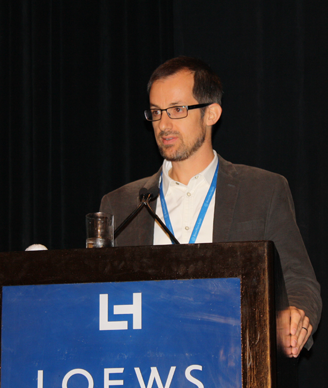Genomic Analysis Will Reshape Low-Grade Glioma Classification, Treatment
New research suggests that characterizing low-grade gliomas according to molecular markers may be a more useful approach in order to guide treatment decisions.
Roel G. W. Verhaak, PhD, speaking at the SNO Annual Scientific Meeting.

Though traditional histologic classification will still have a role, new research suggests that characterizing low-grade gliomas (LGGs) according to molecular markers may be a more useful approach in order to guide treatment decisions. Using IDH mutation and 1p/19q co-deletion status would even take one form of LGG and reclassify it closer to the more dangerous glioblastoma.
Roel G. W. Verhaak, PhD, of MD Anderson Cancer Center in Houston, spoke about classification of LGGs at the Society for Neuro-Oncology (SNO) Annual Scientific Meeting in Miami. “Can we define the clinically relevant molecular classification for this disease?” He cited previous work that showed better outcomes in LGG with oligodendroglioma, lower grade disease, IDH1 or IDH2 mutations, and 1p/19q co-deletion.
In this study, Verhaak’s group analyzed 293 LGGs using multiple genomic and proteomic platforms. They also sequenced 23 whole genomes, and used mRNA sequencing on 269 samples, and matched these data up with outcomes. “There seemed to be three major groups consistently identified,” he said. Those three groups were IDH1/IDH2 wild-type; IDH1/IDH2 mutant but with 1p/19q intact; and IDH1/IDH2 mutant with 1p/19q co-deletion.
“IDH wild-type shows genomic hallmarks of glioblastoma multiforme,” Verhaak said. “The IDH mutant, 1p/19q co-deletion performs best. The IDH wildtype is dismal, with a median survival of about 18 months.” The IDH mutant/1p/19q co-deletion group was not dominated by any particular histology (astrocytoma, oligodendroglioma, or oligoastrocytoma) or tumor grade. The poorer performing group, IDH wildtype patients, were most commonly grade III astrocytomas (55%), though the rest were of mixed grade and histology. A number of specific other mutations were highlighted as characteristic of the various groups, included a high rate of ATRX mutation in the IDH mutant/1p/19q co-deletion group.
Both of the IDH mutant groups had more favorable median survival. Verhaak noted that “IDH status and 1p/19q are routinely determined in a clinical setting, so these are practical to implement.”
In a press conference, conference chair Patrick Wen, MD, of Dana-Farber Cancer Institute in Boston, agreed that it seems IDH wild-type LGGs “act” like glioblastoma. “That is going to change how we treat those patients,” he said. “I think this really clarifies the genomic situation in LGGs significantly. I think people will begin to tailor their treatments based on this study.”
Several experts agreed during the press conference that histology will still play some role, but this study suggests increasing emphasis should be placed on molecular analysis. To some extent, they noted, this is already happening in practice.
Newsletter
Stay up to date on recent advances in the multidisciplinary approach to cancer.